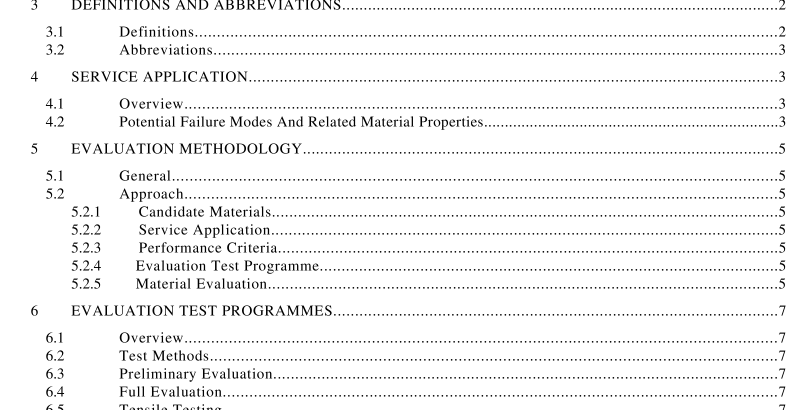API TR 17TR1:2003 pdf free download.Evaluation Standard for Internal Pressure Sheath Polymers for High Temperature Flexible Pipes
3 DEFINITIONS AND ABBREVIATIONS 3. 1 DEFINITIONS For the purposes of this standard, the following definitions apply:
3.1 .1 Flexible Pipe: An assembly of a pipe body and end fittings. The pipe body comprises a composite of layered materials (polymeric and metallic) that form a pressure containing conduit. The pipe structure allows large deflections without a significant increase in bending stresses. The term “pipe” is used in this document as a generic term for unbonded flexible pipe.
3.1 .2 Conventional Flexible Pipe: An unbonded flexible pipe which is suitable for internal fluid temperatures of up to 130°C.
3.1 .3 High Temperature Flexible Pipe: An unbonded flexible pipe which is suitable for internal fluid temperatures of between 130 and 200°C.
3.1 .4 Internal Pressure Sheath: The innermost contiguous polymeric layer of an unbonded flexible pipe, designed to contain transported fluids and ensure pipe integrity.
3.1 .5 Candidate Polymer: A polymeric material which is proposed for use as the internal pressure sheath of an unbonded flexible pipe and is being submitted for evaluation testing.
3.1 .6 End Fitting: A mechanical device which forms the transition between the flexible pipe body and the connector. The different pipe layers are terminated in the end fitting in such a way as to transfer the load between the flexible pipe and the connector.
3.1 .7 Test Temperature, Test Pressure: The temperature (T) and pressure (P) at which a test is to be run for the purposes of evaluating a candidate polymer. The choice of test temperature/pressure will depend only on the performance requirements for the proposed application.
3.1 .8 Test Result: The outcome of a materials test. This may be in the form of a physical quantity (e.g., Young’s modulus) or a subjective rating (e.g., blister damage).
3.1 .9 Maximum Property Temperature (MPT): The maximum temperature for which a specified property meets the performance criterion; for example, if a candidate polymer swells 50% in oil at 165°C, but only 1% at 160°C, its MPT (for compatibility with the oil) is 160°C, assuming that 1% volume swell has been defined as acceptable for the application. See Figure 1.
3.1 .1 0 Maximum Service Temperature (MST): The maximum temperature for which all measured properties meet the specified performance criteria. In practice, there is little point in testing above the rapid gas decompression (RGD) MPT (other than when conducting accelerated ageing based on another property). If the MPT value of another property is lower then it will give the MST. For example, if a candidate polymer has the following MPTs – RGD (190°C), tensile (>190°C), crack growth fatigue (165°C), liquid compatibility in three different fluids (180°C, >190 °C, 170°C) – then the MST for the material is defined by the lowest MPT, that is, 165°C. See Figure 2. It is implicit that MST is significantly below candidate polymer melting point.
3.1 .1 1 Maximum Pipe Service Temperature (MPST): The maximum temperature for which all measured properties meet performance criteria specific to a particular flexible pipe design. For example, the analysis of a particular design might indicate that the allowable strain in a material with a MST of 180°C is exceeded under certain bending conditions at 175°C but not at 170°C—hence MPST must be set to 170°C. Note that the determination of MPST is beyond the scope of this evaluation standard; it is included here for completeness. See Figure 1.
3.1 .1 2 Evaluation Criterion: A predetermined criterion against which test results are compared in order to facilitate the evaluation of a candidate polymer.
3.1 .1 3 Performance Criterion: A performance criterion specifies an acceptable range or limit for a measurable material property, within which a candidate polymer must lie if it is to have any chance of functioning successfully in the high temperature flexible pipe application.
3.1 .1 4 Extrusion: For flexible pipe application, extrusion is the preferred term to describe the deformation (“flow”) of the pressure sheath into armour gaps as a result of applied pressure. Extrusion (of a semi-crystalline polymer) has three components: elastic extrusion, the instantaneous response to the applied stress, plastic extrusion (irrecoverable deformation of the polymer) and time-dependent creep extrusion. For completeness, the definition of creep is also provided. NB Internal pressure sheaths are normally produced by a manufacturing process also termed extrusion, involving polymer melt flow. This is only referred to herein by the term “extruded pipe” or the like.
3.1 . 1 .5 Creep: The increase in strain of a viscoelastic material as the result of a constant applied stress. The response of an amorphous polymeric material to the stress commences with an instantaneous elongation, followed by creep (rapid at first, then slowing to a constant rate). The viscoelastic term creep has both elastic and viscous components. When the stress is removed, the creep deformation is not completely reversible;API TR 17TR1 pdf download.API TR 17TR1:2003 pdf free download
